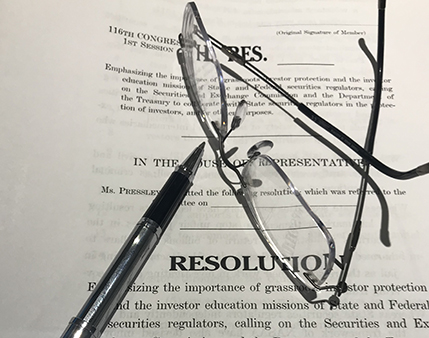PRINCIPAL CONSIDERATIONS FOR REGULATORY ACTIONS
NASAA believes that it is important to encourage firms to create a culture of compliance from the top level of the firm’s management to all of the firm’s agents and/or employees. NASAA believes that members may, in their sole discretion, take into account the following considerations when determining what enforcement action, if any, should be taken against a broker-dealer when a violation has occurred. However, NASAA does not believe that a firm’s cooperation and/or proactive steps should necessarily absolve firms from responsibility and/or liability or preclude the initiation of any enforcement proceeding.
Set forth below are certain considerations that members may consider taking into account in instances where firms demonstrate effective, proactive measures to address problems. These “Principal Considerations” are not intended to provide formal guidance, but rather to encourage firms to self-police, self-report and act in a cooperative manner with NASAA members. Accordingly, these “Principal Considerations” shall not be deemed to provide a basis for a firm to challenge a member’s decision to initiate an action or proceeding.
(NOTE: Click here to download a copy of this document in pdf form.)
1. Did the firm have adequate written supervisory policies and procedures in place to identify and prevent the misconduct at issue? Did the firm have qualified supervisory personnel assigned to implement those policies and procedures? Is there a “tone at the top” regarding the importance of an effective compliance program within the firm? Was the misconduct discovered because of internal compliance procedures?
2. Has the firm taken prompt and adequate measures to avoid future occurrences of the same type of misconduct? What assurances are there that the conduct is unlikely to recur? Did the company adopt and ensure enforcement of new and more effective internal controls and procedures designed to prevent a recurrence of the misconduct? Did the company provide regulatory and law enforcement agencies with sufficient information to evaluate the company’s measures to correct the situation and ensure that the conduct does not recur?
3. Did the firm conduct a review of all facts involved in the misconduct and make a diligent effort to identify all parties involved? Did the company commit to learn the truth, fully and expeditiously? Did it conduct a thorough review of the nature, extent, origins and consequences of the conduct and related behavior? Did management, the Board or committees consisting solely of outside directors oversee the review? Did company employees or outside persons perform the review? If outside persons performed the review or outside counsel was involved, were these entities previously engaged in other work for the company? Were scope limitations placed on the review? If so, what were they?
4. Did the company promptly make available to state securities regulators the results of its review and provide sufficient documentation reflecting its response to the situation? Did the company identify possible violative conduct and evidence with sufficient precision to facilitate prompt enforcement actions against those who violated the law? Did the company produce a thorough and probing written report detailing the findings of its review? Did the company voluntarily disclose information not directly requested by the state securities regulators and that otherwise might not have been uncovered? Did the company ask its employees to cooperate with the state securities regulators and make all reasonable efforts to secure such cooperation? Did the company cooperate completely with appropriate regulatory and law enforcement bodies? Did the company identify what additional related misconduct is likely to have occurred?
5. Was the nature of the misconduct of the agent or employee the result of inadvertence, inadequate training, error, simple negligence, reckless or deliberate indifference to indicia of wrongful conduct, willful misconduct or unadorned venality? Did the firm take timely action against the agent and was such action appropriate to the level of misconduct? Are persons responsible for any misconduct still with the company? If so, are they still in the same positions?
6. Where appropriate, did the firm notify the self-regulatory authorities and federal and state regulatory authorities and/or criminal authorities in a timely and appropriate manner? Did the firm notify the CRD and IARD systems of appropriate disclosure in a timely manner?
7. Did the firm act promptly and fully in addressing client complaints and/or losses prior to any intervention by a regulatory agency? For example, did the firm seek out persons or entities harmed by the wrongdoing and offer restitution without state or other regulatory intervention? Did the company take steps to identify the extent of damage to investors and other corporate constituencies?
8. Does the firm have a history of misconduct, and in particular, of the misconduct at issue?
9. What affect would the proposed regulatory action have on public policy concerns?
10. What, if any, “red flags” were present that should have warned the firm of potential problems? Did the firm act on those indications on a timely basis?
11. How did the misconduct arise? Is it the result of pressure placed on employees to achieve specific results, or a tone of lawlessness set by those in control?
12. Where in the organization did the misconduct occur? How high up in the chain of command was there knowledge of, or participation in, the misconduct? Did senior personnel participate in or ignore obvious indicia of misconduct? How systemic was the behavior? Is it symptomatic of the way the entity does business, or was it isolated?
13. How long did the misconduct last? Was it a one-time event or did it last several years?
14. How much harm has the misconduct inflicted upon investors and other corporate constituencies? Did the share price of the company’s stock drop significantly upon its discovery and disclosure?
15. How was the misconduct detected and who uncovered it?












